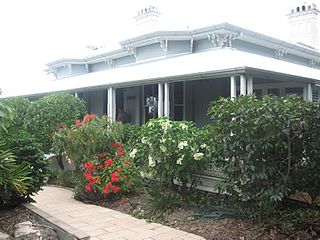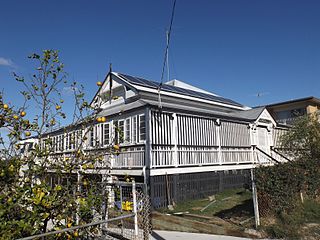| Doggetts Cottage | |
|---|---|
 | |
| Location | 33 Arthur Street, Fortitude Valley, City of Brisbane, Queensland, Australia |
| Coordinates | 27°27′37″S153°02′20″E / 27.4604°S 153.0389°E Coordinates: 27°27′37″S153°02′20″E / 27.4604°S 153.0389°E |
| Design period | 1870s - 1890s (late 19th century) |
| Built | c. 1880 |
| Built for | Harry Doggett |
| Official name: Doggetts Cottage | |
| Type | state heritage (built) |
| Designated | 21 October 1992 |
| Reference no. | 600258 |
| Significant period | 1880s (fabric) 1880s-1920s (historical) |
| Significant components | kitchen/kitchen house, stables, well, attic, residential accommodation - main house |
| Builders | Harry Doggett |
Doggetts Cottage is a heritage-listed cottage at 33 Arthur Street, Fortitude Valley, City of Brisbane, Queensland, Australia. It was built c. 1880 by Harry Doggett. It was added to the Queensland Heritage Register on 21 October 1992. [1]

A cottage is, typically, a small house. It may carry the connotation of being an old or old-fashioned building. In modern usage, a cottage is usually a modest, often cosy dwelling, typically in a rural or semi-rural location.

Fortitude Valley is a suburb of central Brisbane, the state capital of Queensland, Australia. The suburb lies immediately northeast of the Brisbane central business district, and is one of the hubs of Brisbane's nightlife, renowned for its nightclubs, bars and adult entertainment. At the 2016 Australian Census Fortitude Valley recorded a population of 6,978. In the 1950s, the suburb was the largest shopping precinct outside a central business district in Australia.

The City of Brisbane is a local government area that has jurisdiction over the inner portion of the metropolitan area of Brisbane, the capital of Queensland, Australia. Brisbane is located in the county of Stanley and is the largest city followed by Ipswich with bounds in part of the county. Unlike LGAs in the other mainland state capitals, which are generally responsible only for the central business districts and inner neighbourhoods of those cities, the City of Brisbane administers a significant portion of the Brisbane metropolitan area, serving almost half of the population of the Brisbane Greater Capital City Statistical Area. As such, it has a larger population than any other local government area in Australia. The City of Brisbane was the first Australian LGA to reach a population of more than one million. Its population is roughly equivalent to the populations of Tasmania, the Australian Capital Territory and the Northern Territory combined. In 2016–2017, the council administers a budget of over $3 billion, by far the largest budget of any LGA in Australia.






























